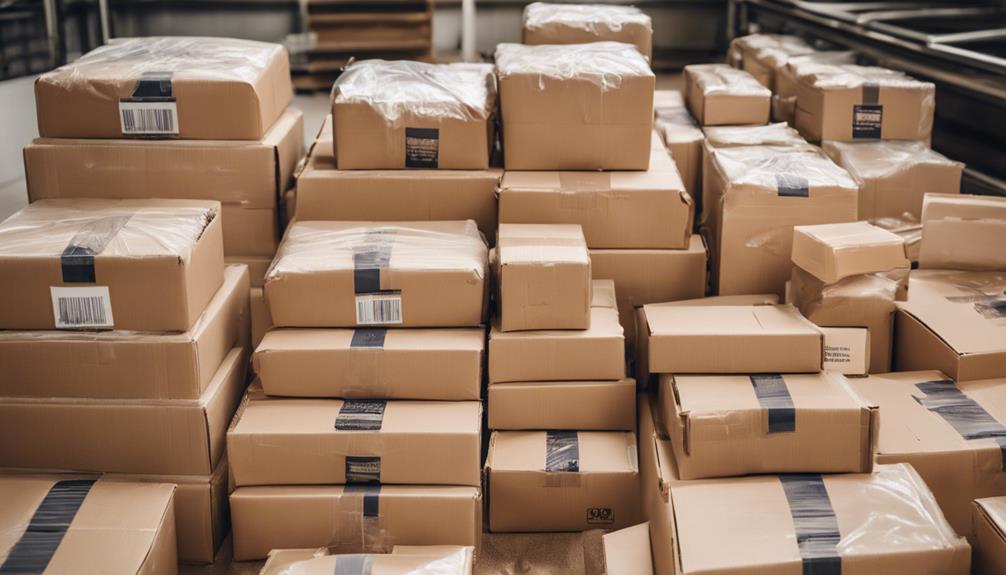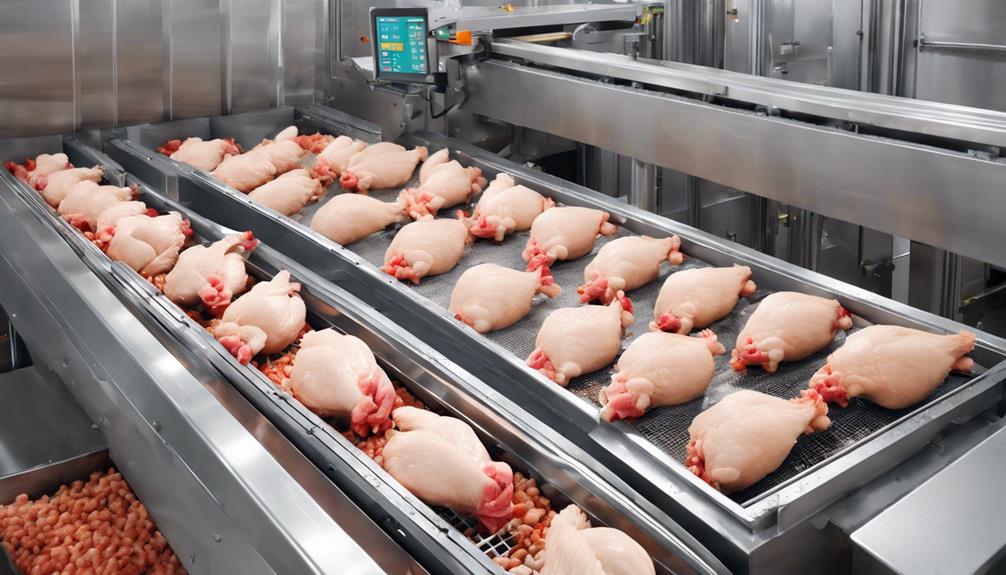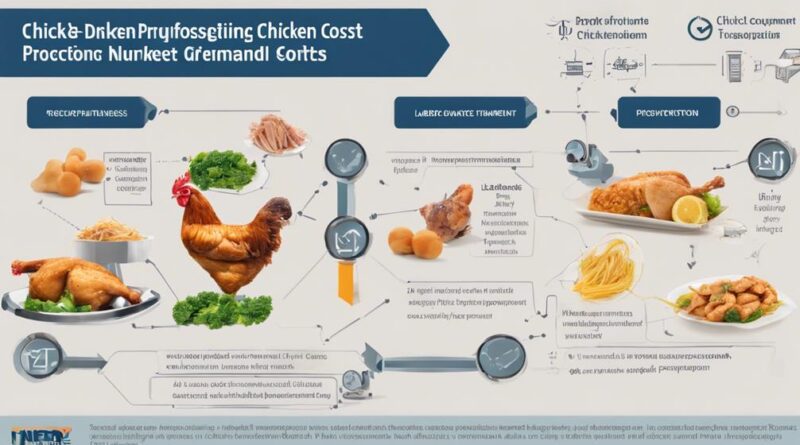Top 10 Factors Influencing Chicken Processing Costs"
When it comes to understanding the intricacies of chicken processing costs, there are various factors at play that can significantly impact the overall financial health of your operations. From labor management efficiency to equipment maintenance and regulatory compliance, each element intertwines to shape the bottom line of your processing costs. As you consider how these top 10 factors influence the economics of chicken processing, you'll realize the importance of a holistic approach to cost management in this dynamic industry.
Labor Costs
Labor costs play a significant role in influencing the overall expenses incurred during chicken processing. By implementing automation benefits in processing plants, the reliance on manual labor decreases, leading to increased efficiency and reduced costs. Automation streamlines the production line, minimizing the time required for tasks such as cutting, deboning, and packaging. This results in lower labor expenses over time, as fewer human workers are needed for these repetitive processes.
Training programs are essential to ensure that employees can effectively operate and maintain automated equipment. Proper training enhances productivity, reduces errors, and ultimately contributes to cost savings in the long run. Well-trained staff can troubleshoot issues quickly, preventing delays in the production process that could lead to higher labor costs.
Investing in automation benefits not only cuts down on labor expenses but also improves overall product quality and consistency. Machines can perform tasks with precision and accuracy, reducing the margin of error that may occur with manual labor. Additionally, automation can increase the processing capacity of the plant, allowing for higher output levels without a proportional increase in labor costs.
Equipment Efficiency
To optimize chicken processing costs further, improving equipment efficiency is paramount. Maintenance strategies play a crucial role in ensuring that processing equipment operates at peak performance levels. Regular maintenance checks, timely repairs, and proactive replacement of worn-out parts can significantly enhance the efficiency and longevity of processing machinery. By implementing a proactive maintenance schedule, downtime due to unexpected breakdowns can be minimized, leading to increased productivity and cost savings in the long run.
In addition to maintenance strategies, technology upgrades can also greatly impact equipment efficiency. Investing in modern technology that automates certain processes, improves accuracy, and enhances speed can streamline operations and reduce processing time. Upgrading to more energy-efficient equipment can also lead to cost savings by reducing electricity consumption.
Furthermore, technology upgrades can enable better data collection and analysis, providing insights into equipment performance and potential areas for improvement. By leveraging data-driven decision-making, processors can fine-tune equipment settings, optimize production workflows, and identify opportunities for further efficiency gains.
Feed Prices
Feed prices play a crucial role in determining the overall production costs of chicken processing operations. The cost of feed constitutes a significant portion of the total expenditure in poultry farming. Fluctuations in feed prices can directly impact the financial performance of chicken processing facilities. The dynamics of feed pricing are influenced by various factors within the supply chain and market demand.
Within the supply chain, factors such as the availability of key ingredients like corn and soybeans, which are staple components in poultry feed, can greatly affect feed prices. Weather conditions, geopolitical events, and trade policies also play a role in shaping the cost of feed ingredients. Any disruption in the supply chain can lead to price volatility, impacting the overall operational costs for chicken processors.
Market demand is another crucial aspect that influences feed prices. As the demand for poultry products increases, the need for feed rises correspondingly. This heightened demand can exert pressure on feed prices, especially if there are limitations in the production or availability of key feed ingredients. Understanding the interplay between market demand and feed prices is essential for chicken processing facilities to effectively manage their cost structures and remain competitive in the industry.
Energy Expenses
Energy expenses in chicken processing operations significantly impact the overall operational costs and require careful monitoring to optimize efficiency and profitability. Implementing renewable energy sources and cost-saving techniques can play a vital role in reducing energy expenses. By utilizing solar panels, wind turbines, or biomass systems, chicken processing plants can lower their reliance on traditional energy sources, consequently decreasing costs over the long term.
Integrating energy-efficient technology is another effective strategy to minimize energy expenses. Upgrading to high-efficiency LED lighting, investing in energy-efficient machinery, and optimizing heating, ventilation, and air conditioning systems can lead to substantial savings. Additionally, adopting sustainability practices such as proper insulation, regular maintenance of equipment, and monitoring energy consumption patterns can further enhance cost-effectiveness.
Analyzing energy consumption data and conducting energy audits can provide valuable insights into areas where improvements can be made. By identifying energy-intensive processes and implementing targeted solutions, chicken processing plants can streamline their operations and reduce overall energy expenses.
Transportation Charges
Considering the significant impact of energy expenses on operational costs, it's crucial to now shift the focus to examining the influence of transportation charges in chicken processing operations. Transportation charges play a vital role in the overall cost structure of chicken processing due to their direct impact on the supply chain and distribution logistics.
Transportation costs are a key component of the supply chain in the poultry industry. Efficient transportation is essential to ensure the timely delivery of raw materials to processing plants and the distribution of finished products to customers. Any increase in transportation charges can significantly affect the overall cost of operations, as it directly impacts the movement of goods along the supply chain.
In the realm of distribution logistics, transportation charges can vary based on factors such as fuel prices, distance traveled, and shipping volume. Optimal route planning and load optimization are critical in minimizing transportation costs. Any inefficiencies in transportation logistics can lead to increased expenses, impacting the competitiveness of chicken processing facilities in the market.
To mitigate the impact of transportation charges on processing costs, companies often invest in technologies like route optimization software and efficient vehicle fleet management. By leveraging data analytics and technology, chicken processing plants can streamline their transportation operations, reduce costs, and improve overall efficiency in the supply chain.
Regulatory Compliance
When ensuring operational efficiency in chicken processing, regulatory compliance stands as a critical factor influencing overall costs. Meeting inspection protocols and government regulations is paramount in maintaining a processing facility's license to operate. Failure to comply can result in fines, shutdowns, or legal actions, all of which significantly impact the bottom line. Compliance audits are routine in the industry to ensure adherence to both government regulations and industry standards. These audits often require extensive documentation, staff training, and process adjustments to meet the stringent requirements set forth by regulatory bodies.
Non-compliance with inspection protocols can lead to increased scrutiny from regulatory agencies, potentially resulting in more frequent audits and heightened oversight. This increased regulatory scrutiny can drive up costs as additional resources are allocated to address compliance issues promptly. Moreover, failing to meet industry standards may lead to reputational damage, loss of customers, and decreased market share.
To mitigate the impact of regulatory compliance on processing costs, it's essential for chicken processing plants to invest in robust compliance programs, continuous staff training, and proactive monitoring of regulatory changes. By staying ahead of compliance requirements, companies can avoid costly penalties and maintain a competitive edge in the market.
Packaging Material Costs

Complying with packaging regulations ensures operational efficiency and directly impacts chicken processing costs. Packaging material costs play a significant role in the overall expenses incurred during chicken processing. By adopting sustainability practices, you can achieve cost savings while contributing to environmental protection. Innovative technology offers opportunities for waste reduction, further influencing the bottom line.
Here are some key factors to consider when evaluating packaging material costs:
- Material Efficiency: Opt for materials that strike a balance between durability and lightweight to minimize costs.
- Recyclability: Choose packaging materials that are easily recyclable to support sustainability efforts and potentially reduce expenses.
- Bulk Purchasing: Buying packaging materials in bulk quantities can often lead to cost savings through discounts.
- Automation Integration: Utilizing automated packaging processes can streamline operations, reduce material waste, and cut down costs.
- Supplier Relationships: Cultivate strong relationships with packaging material suppliers to negotiate better prices and terms, potentially reducing overall expenses.
Quality Control Measures
To enhance operational efficiency and minimize costs in chicken processing, implementing stringent quality control measures is imperative. Inspection protocols serve as the foundation for maintaining the quality and safety of chicken products. By establishing comprehensive inspection protocols at various stages of processing, such as receiving, evisceration, and packaging, you ensure that only high-quality products move forward in the production line, reducing waste and reprocessing costs.
Sanitation standards also play a crucial role in quality control. Adhering to strict sanitation practices not only ensures the safety of the product but also extends the shelf life of the chicken. Regular cleaning of equipment, workspaces, and utensils mitigates the risk of contamination, safeguarding the overall quality of the processed chicken.
Moreover, quality control measures directly impact production efficiency and yield optimization. By consistently monitoring and evaluating the processes through quality control checkpoints, you can identify areas for improvement, reduce defects, and enhance overall productivity. This proactive approach not only maintains quality standards but also contributes to cost savings by minimizing rework and enhancing the yield of valuable product parts.
Processing Line Speed

Ensuring optimal processing line speed is crucial for maintaining efficiency and productivity in chicken processing operations. The speed at which chickens move along the processing line can significantly impact various aspects of the operation.
- Worker Safety: Maintaining an appropriate processing line speed is essential to ensure the safety of workers. High speeds can lead to increased risk of accidents and injuries, while excessively slow speeds can result in inefficiencies and ergonomic issues for workers.
- Technology Integration: Implementing advanced technology in processing lines can help optimize speed and efficiency. Automated systems for tasks such as evisceration and cutting can improve processing speeds while maintaining quality standards.
- Monitoring and Control: Regular monitoring of processing line speed is necessary to identify any bottlenecks or inefficiencies. By closely monitoring the speed at different stages of the process, adjustments can be made to optimize overall efficiency.
- Training and Skill Development: Proper training of staff on how to work efficiently at different processing line speeds is crucial. Well-trained employees can adapt to varying speeds while maintaining product quality and ensuring their own safety.
- Data Analysis: Utilizing data analytics to track processing line speeds and performance metrics can provide valuable insights for improving operations. Analyzing data on line speed alongside other factors can help identify opportunities for optimization and cost savings.
Waste Management Systems
Maintaining optimal processing line speeds in chicken processing operations is closely linked to the effective management of waste generated in the production process. Waste reduction strategies are crucial in minimizing the environmental impact of chicken processing plants. Implementing efficient waste management systems not only helps in reducing operational costs but also aligns with sustainability goals.
To achieve effective waste management, chicken processing plants can adopt various strategies. One approach is to optimize the use of by-products and leftovers through recycling or repurposing. This not only reduces waste but also contributes to cost savings. Additionally, investing in technologies that facilitate waste segregation at the source can enhance recycling efforts and minimize overall waste generation.
Cost-effective disposal methods play a significant role in managing waste in chicken processing operations. Collaborating with waste management companies that specialize in handling food industry by-products can ensure proper disposal while adhering to environmental regulations. By choosing disposal methods that prioritize recycling and reuse, chicken processing plants can align their waste management practices with sustainability goals, promoting eco-friendly operations.
Frequently Asked Questions
How Do Market Trends Impact Chicken Processing Costs?
Market trends can significantly impact chicken processing costs. Fluctuations in demand affect supply chain operations and pricing strategies.
By conducting cost analysis, businesses can adjust production levels to meet changing market needs. Understanding market trends allows for strategic planning to optimize resources and minimize expenses.
Staying informed and adapting to market shifts is crucial for managing chicken processing costs effectively.
What Are the Effects of Weather Conditions on Processing Expenses?
Weather conditions can significantly impact processing expenses in chicken production. Extreme temperatures, storms, or droughts can disrupt production efficiency, leading to higher costs.
For example, heat stress can reduce bird growth rates, increase mortality, and require additional resources for cooling. On the other hand, severe weather events may disrupt supply chains, causing delays and affecting overall processing costs.
Understanding and preparing for these weather-related challenges is crucial for managing processing expenses effectively.
Can Technological Advancements Reduce Processing Costs?
To reduce processing costs, technological advancements play a crucial role. Automation efficiency can streamline operations, cutting down on labor expenses. Technological innovations provide opportunities for cost reduction through improved processes and equipment.
How Do Employee Training Programs Affect Overall Expenses?
Employee training programs play a crucial role in enhancing skills and productivity, leading to improved efficiency and reduced errors. By investing in training, you can boost employee retention rates, decrease turnover costs, and ultimately achieve long-term cost savings.
Well-trained staff are more adept at performing tasks accurately and efficiently, translating into smoother operations and lower overall expenses. Prioritizing employee development can positively impact your bottom line and operational effectiveness.
What Is the Impact of Chicken Size Variation on Processing Costs?
When chicken sizes vary during processing, it can impact efficiency and labor costs.
Inconsistencies in size may require adjustments in processing techniques, leading to increased labor time and potential waste.
Maintaining size consistency can improve overall efficiency by streamlining operations and reducing the need for manual adjustments.
This, in turn, can help control labor costs and optimize processing workflows for better productivity.
Conclusion
In conclusion, optimizing labor management efficiency, equipment performance, feed cost management, energy practices, and transportation logistics are crucial for cost-effective chicken processing operations. Regulatory compliance, packaging strategies, and quality control procedures also play significant roles. Additionally, focusing on processing line optimization and waste management practices is essential.
By addressing these top 10 factors, businesses can reduce expenses, improve competitiveness, and achieve sustainable growth in the industry. It's crucial to continually evaluate and improve these factors to ensure success in the ever-evolving chicken processing market.
